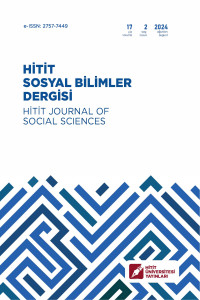Moda Tasarımı Eğitiminde Desen (Figür Çizimi) Dersinin Öğrenci Görüşlerine Göre Değerlendirilmesi
Evaluation of Drawing (Figure Drawing) Course in Fashion Design Education According to Student Opinions
Author(s): Burcu BaşaranSubject(s): Visual Arts, Higher Education , Sociology of Art
Published by: Hitit Üniversitesi
Keywords: Fashion Design; Art Education; Figure Drawing; Design Education; Visual Culture;
Summary/Abstract: Fashion is a concept that is also a product of visual culture and takes its source from visual culture, is intertwined with the life of the individual, and appears in different aspects of the changing processes of time, to create aesthetic and comfortable forms of human life. While the rather wide range of fashion brings diversity to fashion education, the production of fashion products in aesthetic forms has led to the necessity of art education, and the production of fashion products with the right methods has led to the necessity of technical education. Fashion design education is a form of design education in which artistic and vocational technical education is taught to the student through blending them correctly. Besides, vocational and technical courses; art education, which is taught in fashion design education with the basic education logic is the result of the multi-directional education approach provided to the fashion design student. Art education-based courses, especially taught in the first years develop the student's creativity, originality, aesthetic point of view and aesthetic expression style. Drawing (Figure Drawing), which is one of the most important of these lessons, is a basic course that teaches the student to see and perceive and to express what they can see and perceive in an aesthetic way. Thanks to this course, the student, who gains observation and shaping skills through developing aesthetic sensitivity will receive basic artistic training for the fashion design program designed to dress the human body aesthetically and functionally. In this article, which was investigated on this perceived need, the importance, position, process and content of the Drawing (Figure Drawing) course for the fashion design program were examined and the opinions and expectations of Selcuk University fashion design students about the course were tried to be set forth. The position and content of the Drawing (Figure Drawing) course in the fashion design program were tried to be determined in the Bologna programs found on the university websites and the course information packages in the program. Descriptive analysis was used in the study conducted with the literature research and qualitative research method, and semi-structured questions were used in the interviews with the purposeful sample group. In the purposefully selected sample group in the study, some students are admitted by the Talent Exam, and some are admitted by the Central Examination System. In particular, students studying in different periods and groups were reached. With this approach, the unbiased opinions of the students who came to the department by drawing before and the students who did not know about drawing before university were collected and compared by descriptive analysis. When the departments of fashion design and textile and fashion design at the undergraduate education level in Turkey are examined, it is seen that these departments accept students with a special talent exam based on the Pattern (Figure Drawing) course and training, which is a necessary education, or with a central examination system that includes completely general theoretical courses or portfolio examinations. According to the findings obtained from the interviews in the study, almost all of the students who were admitted both to the talent exam and the central examination system considered the Drawing (Figure Drawing) course quite necessary for their education. Considering their success status, it was understood from their statements that the students who took the talent exam were more successful. It was determined that the students who took the central exam drew more still-life, lifeless models such as lifeless mannequins and tors due to their lack of pre-qualification and readiness. While the students who took the talent exam expressed their opinions on more advanced subjects, such as drawing faster and drawing what they imagined, the students who took the central examination system. The students who took the central exam reported that they would like to draw more different things, that they would like to be told more about drawing knowledge at the beginning of the course, and that they would like the instructor to be more interested, to give information frequently, and to warn and correct mistakes. Their common answers can be regarded as being able to draw more live models, providing models from outside, improving the workshop environment, using different environments, enriching the materials, drawing more fabrics, and enriching the content.
Journal: Hitit Sosyal Bilimler Dergisi
- Issue Year: 17/2024
- Issue No: 2
- Page Range: 283-302
- Page Count: 20
- Language: Turkish

